23 October, 2004
My first glimpse of the research site.
I have been trying to imagine exactly what the site where the researchers are working at Cinder Cones looks like. Today I saw my first picture of the area I've been standing above for the next few days. Check out the photo below!
Having removed the fence and taken most of the sediment cores, the divers could focus today on removing a little more equipment and taking pictures of settling plates that were laid down by Dr. Paul Dayton thirty years ago. These are places for organisms to settle on; the idea is that by putting down something with an empty surface, you can see what organisms grow on the surface. By taking pictures each year, the scientists can learn about how quickly the organisms grow from year to year.
The plates are placed at different depths on the slope that goes down away from shore. The deepest of these settling plates is at 130 feet, which is a deep dive. The divers have to be very careful at that depth; a build-up of nitrogen in the blood and in body tissues can lead to a condition called nitrogen narcosis, in which it can become difficult to think straight. This is primarily a safety issue. However, it's also a work issue in that it can be harder to deal with equipment at that depth.
The divers are using video and still cameras. They will be using a time-lapse camera too, but it seems that the camera was accidentally put on a ship instead of a plane! This will make its arrival time later than expected.
Leaving the dive hut this afternoon, we saw two Weddell seals lying near our road back to the main road. You may remember reading about what it means to see seals on the ice. Where there are seals, there are cracks! We knew there were some cracks in the area, but this means that we need to be very careful about where we drive.
We stopped and looked at the seals and they looked at us. We found some seal poop, which is a little bit like dry horse poop. Stacy, who has quite a reputation for a professional interest in poop, picked some up to check out and everyone gathered around. OK, I admit, I picked at it a little too. It's full of little fish bones - vertebrae and ribs and pieces of fin. There were also some things that looked like little crustacean shells. It didn't really smell great, but I'm sure it would have been far worse if the weather had been warmer and more humid!
Last night we had a little recreation in the form of a bowling competition against the rival lab of Adam Marsh from the University of Delaware - alias the "Marshians." Yes, there is bowling in Antarctica. In the building where the weight room is located, there's a two-lane bowling alley where you can do regular and "cosmic" bowling. In cosmic bowling, the pins are fluorescent colors and the lanes are lit with black lights.
We showed up in spiffy uniforms of assorted boxer shorts, and were astonished to find that our opponents had black and leopard-print bowling shirts with their names embroidered on them. Sadly, this was a sign of the outcome of the competition, and we were trounced. For all the gory cosmic bowling details, check out the ASPIRE update at aspire.mlml.calstate.edu/aspire04/updates/ and go to October 22.

1. A diver under the ice at Cinder Cones.
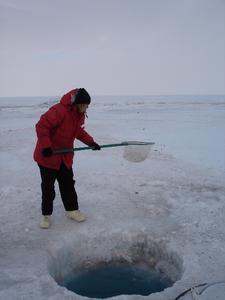
2. Removing the ice from the surface of the safety hole at the strt of the day.
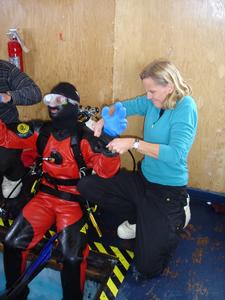
3. Helping Bob get a drysuit glove on. There must be a perfect seal between the glove and the suit or it will develop a leak. If the suit leaks, the dive has to be cut short.
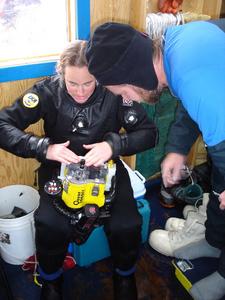
4. Jennifer checks out the video camera after her dive to 130 feet.
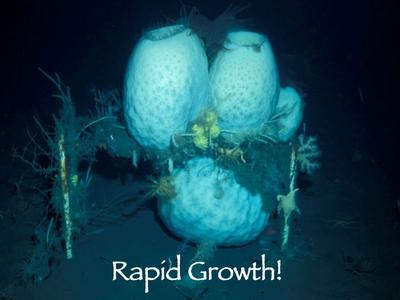
5. These aren't the settling plates at Cinder Cones, but they are structures where the same thing has happened - organisms have settled on it and grown. These sponges are 80 centimeters (more than 2 feet) tall!
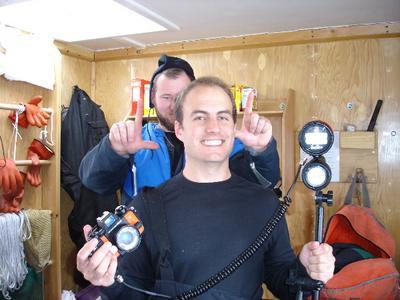
6. Andrew demonstrates the Nikonos, while Mike frames Andrew.
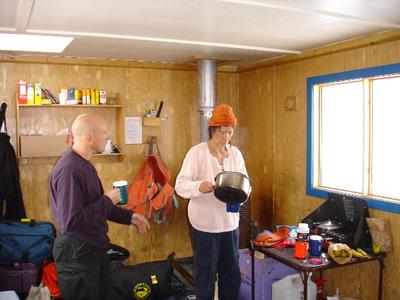
7. Stacy makes hot chocolate after her dive.
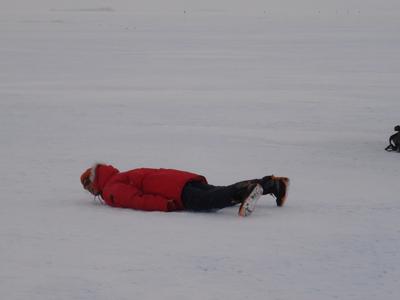
8. Stacy demonstrates her seal belly-sliding technique.

9. Examining the seal poop.
Contact the TEA in the field at
.
If you cannot connect through your browser, copy the
TEA's e-mail address in the "To:" line of
your favorite e-mail package.
|
